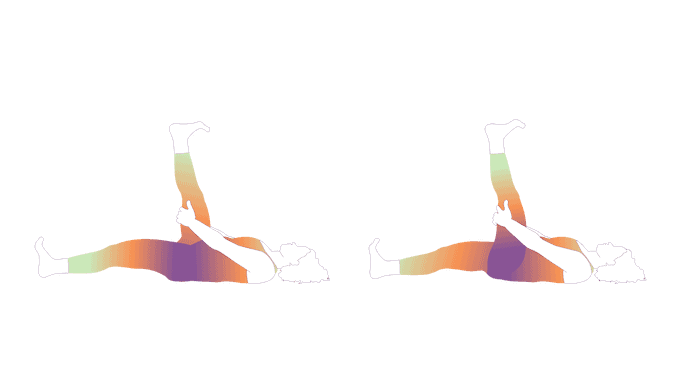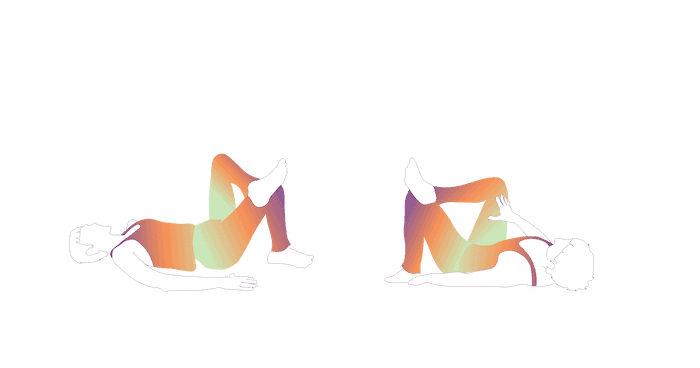
For some with hip bursitis, yoga can be a safe, practical, and effective way to alleviate pain. Hip bursitis is an uncomfortable and sometimes debilitating condition, particularly when it is chronic. Studies have shown that yoga can help with mobility, managing pain, and reducing stress, which makes it an excellent option for hip bursitis. But first, it’s important to understand which yoga poses to avoid with hip bursitis, which yoga techniques can help, and how to safely get started.
If you’ve seen a doctor, rested your hip, and perhaps even tried medications or injections as prescribed to no avail, it may be time to give yoga a try. I’m Brandt Passalacqua, a certified yoga therapist and co-founder of the Breathing Deeply Yoga Therapy school. My mission is to help others heal with yoga, which is why I’m here to explain everything you need to know about yoga for hip bursitis.
Keep reading to learn more or contact us to work with a yoga therapist for your hip bursitis.
Table of Contents:
Finding holistic approaches to improving mobility and reducing pain is a common goal among those with hip bursitis. Yoga can provide this type of approach thanks to its large variety of hip-focused poses that reduce stiffness, expand range of motion, strengthen muscles that support the hips, and minimize discomfort while moving.
Those suffering from hip bursitis may benefit from yoga in 5 main ways:
To better support and stabilize the hip joint, many yoga poses work to strengthen the muscles in and around it. These include the glutes, the outer hip muscles, and the quadriceps. This not only promotes healthy posture and alignment, but also reduces muscular imbalances that can cause pain and limit mobility.
Yoga’s emphasis on self-awareness, deep breathing, and other relaxation methods makes it an effective tool for combating stress. This can make it easier to manage pain when it does occur.
By knowing which yoga poses to avoid with hip bursitis and which ones may work best, it’s possible to increase blood flow directly in and around the hip area. Increased blood flow delivers oxygen and nutrients to working muscles, reduces inflammation, and benefits the hips as a whole.

Always pay attention to how your body reacts to different movements or holds, and stay away from poses that feel too strenuous. In general, avoid anything that irritates the hip, which usually involves the ends of your range of motion.
Some of the most common yoga poses to avoid with hip bursitis are:
This is not an exhaustive or exclusive list. When determining which yoga poses to avoid with hip bursitis for yourself, keep the following advice in mind:
Another way to safeguard your hips during yoga is by consulting with a certified yoga therapist or healthcare practitioner who is familiar with your condition. Comfort and safety should always come first. A yoga therapist can teach you about appropriate adjustments and alternative poses that work well for those with hip bursitis.

Now that you know which yoga poses to avoid with hip bursitis, we can turn our attention to what you can do instead. People who suffer from hip bursitis can easily adapt a variety of different yoga poses to their specific needs.
The key to using yoga for hip bursitis is to avoid movements that cause pain, avoid repetitive hip movements, and avoid pushing yourself too far when stretching. Even if you don’t feel pain in the moment from repetitive movements or deep stretches, your hip will probably hurt later. Stretching can release chemicals in your brain that can even make it feel good, but if you’re irritating the burse, you’re going to feel it later.
Be sure to really rest your hip long enough for it to get better. Even if you only recently got hip bursitis, you can still move and be active, but take care to let your hip rest and heal.
To help you modify yoga poses safely and effectively, use these additional tips:
By increasing circulation to the hip area and loosening up the hip flexors, certain yoga poses can offer relief to those with hip bursitis. Poses that gently stretch and strengthen the muscles around your hips (such as the glutes, outer hip muscles, and quadriceps) tend to be especially beneficial.
When using yoga therapeutically, there is no one-size-fits-all solution. By its very nature, yoga therapy takes into account an individual’s specific health conditions, history, lifestyle, and desired outcomes to determine which yoga techniques to use and how to apply them.
For this reason, I can’t say there are certain yoga poses that will work well for everyone with hip bursitis. But there are some poses that may be more likely to help and avoid common contraindications.

Half Locust Pose is a pose performed while lying prone on your stomach. It involves lifting one leg up behind you while keeping the rest of your limbs on the floor. By targeting a single leg at a time, it focuses on strengthening the hamstrings and glutes. The glutes are often weak in those with hip bursitis, contributing to poor usage of the hip joint.
Rather than simply holding this pose, I recommend lifting the leg, pausing, lowering it, and repeating several times on the same leg before switching to the other side. This will help build up greater strength in the glutes, supporting good hip function.

By gradually stretching the hip flexors, you can increase your flexibility and mobility with the Reclining Big Toe Pose. While lying on your back, you’ll keep one leg extended on the mat and the other extended toward the ceiling, held in place by your fingers. This stretch relieves stress on the hip joints by lengthening the groin muscle.
Controlling your movement in this pose is key for those who suffer from hip discomfort, as it enables you to tailor the intensity of the stretch to your unique needs. This kind of gentle and controlled stretching increases blood flow to the hip region as well.

To practice Figure-Four Pose (also known as One-Legged Chair Pose, Half Chair Pose, and Whooping Crane Pose), you bring one foot over the knee of the other leg while bending slightly at the hips, as if sitting in the air. For the supine version that I recommend, you practice this position while lying on your back instead of standing. The result is a good hip stretch that especially benefits the hip flexors and external rotators.
This stretch can help loosen up stiff hips and improve mobility. It can also be easily adjusted to the appropriate depth by moving your hips and torso lower or higher as needed. To hold this position, you’ll need to use your glutes and external rotators, among other hip muscles, building on their strength.
So far, our focus has been on yoga poses to avoid with hip bursitis and ones to consider instead. But yoga offers more techniques than just asanas, or yoga poses.
Pranayama, or breathing techniques, can be used as pain management tools for hip bursitis. Breath work can reduce stress, instill a sense of calm, reduce pain, and boost general health and happiness. Two types of breathing exercises in particular to consider for dealing with stress and pain are diaphragmatic breathing and alternate nostril breathing.
Yoga nidra is a practice that brings you into a relaxed state between wakefulness and sleep. Most often, a professional guides you through yoga nidra while you lie down. One of its chief benefits is that it is similar to meditation but requires less skill to achieve results.
Hip flexors are only one muscle group that benefits from yoga nidra’s methodical approach to restfulness. Yoga nidra can help induce healing brainwave states, which can potentially help you heal faster. It can also improve your sleep, which can improve healing too.
Yoga nidra can change how you experience pain, anxiety, or trauma. It helps you to regulate your responses, feel calmer, and change your perspective.

Yoga can bring a wide variety of benefits to your life, including increased happiness, less pain, more mobility, and better overall health. To get the best results from doing yoga, it’s helpful to work with a professional yoga instructor or yoga therapist.
Because of the uplifting atmosphere and sense of community they foster, many people believe that yoga classes are a great option for those who learn best in a social setting. Those interested in broader health and well-being, as well as a more general yoga experience, will find that group classes provide the best of both worlds.
Yoga classes are led by a trained instructor. The variety of classes available for groups makes it possible to delve into different styles of yoga that may be of interest to you.
When taking part in group yoga, keep in mind that you won’t receive as much individualized attention. As a result, the class may practice some yoga poses you should avoid with hip bursitis. Because of this, it’s best to find a class that moves at a slower speed that allows you to make necessary modifications. But you must be responsible for practicing yoga safely with hip bursitis.
Yoga therapy sessions work well for those seeking help with a specific condition, illness, or injury, like hip bursitis. Your yoga therapist will evaluate your mental, physical, and emotional health to create a holistic approach that addresses your condition therapeutically.
Private yoga therapy sessions take your unique circumstances into account, resulting in better health outcomes. Yoga therapy is targeted to your goals and health, unlike group yoga classes.
If you have chronic hip bursitis, a yoga therapist can teach you techniques to even out your musculature and create an environment in which you are less likely to get hip bursitis again. Best of all, you are empowered to practice these techniques on your own. Like physical therapy, yoga therapy sessions are not intended to go on indefinitely.

Have you been dealing with hip bursitis for weeks? Or hip bursitis that keeps coming back? Yoga therapy may be able to help relieve your pain and prevent it from returning.
I’m pleased to be able to offer private, one-on-one yoga therapy sessions with myself and several other certified yoga therapists via Zoom. Learn more about our private sessions and fill out the contact form on the bottom of the page today to get started.
Brandt talks about common questions applicants have about the Breathing Deeply Yoga Therapy Program. Tune in to get the full program details.
Friends in Yoga, The way we perceive the world is a curious thing. Is it on fire or getting better? Are we facing our challenges or shying away from them? Are we functioning from the present or some altered reality based on past experiences? The teachings tell us that reality is ultimately timeless. The vibration […]
There’s no doubt that yoga is gaining popularity, but you may be asking yourself, what is the most popular type of yoga? Where is each type most popular in the U.S. and around the world? And for those who are interested in trying it themselves, how can you practice these styles of yoga safely? For […]
Friends in Yoga, Sitting on a cushion, taking a yoga class, chanting a mantra before your morning coffee…no one would call these radical acts. They are small choices that we make to better ourselves. The motivation to practice often takes form by our desire to be healthier, to be more focused, to connect with our […]